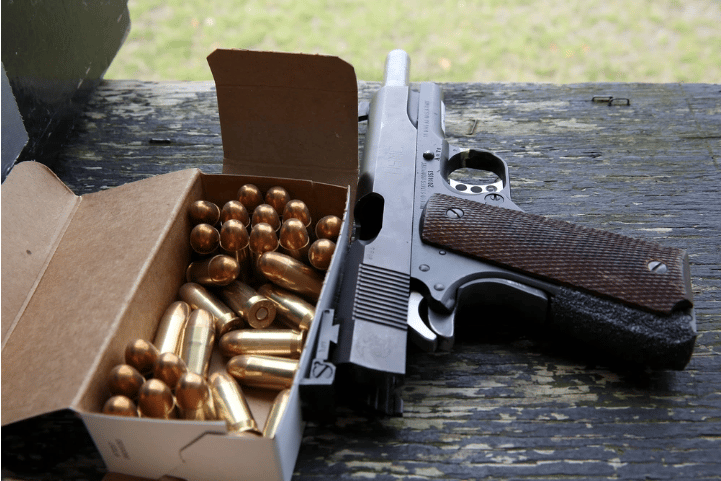The problem facing 1911 pistols these days is that so many manufacturers are making them that they are not all of equal build quality. Old or worn magazines are usually the culprit if you tend to get jams with a high-quality 1911 pistol. That can often be solved just by using a better quality magazine. More on that in a second.
Most 1911s were originally designed to fire “hardball” ammo. With hardball ammo, they very rarely jammed. However, when using more modern hollow point or “truncated” cone ammo, 1911s started to become less reliable.
Inherently, John Browning’s Model 1911 pistol (commercially known through Colt’s as the “Government Model”) is an extremely reliable pistol. During the U.S. Army’s trials of the handgun, the Model of 1911 fired 6000 rounds without a single malfunction, a fair accomplishment even by today’s (over 100 years later) standards, but was unheard of at that point in time.

The myth of the Model 1911 being a “jam-o-matic” comes from three major developments in recent history
Ammunition Inconsistency
When the 1911 was designed, it was designed around the 230gr hardball .45 ACP. This ammunition has a certain geometry that was heavily accounted for in the original design of the pistol. With the rise of JHP and other ammunition varieties, we have seen this cause a problem for some traditional 1911 pistols. Many modern guns have updated their feed ramps slightly to account for this, and “ramped” barrels are a standard on 9mm and Super .38 pistols.
Cleaning
This is a simple one. The pistol needs to be regularly cleaned and lubricated to function optimally. The “age of Glock” has produced a generation of folks who do not regularly maintain their guns. Not a “bad” thing, but it is something you need to consider when owning/shooting/carrying a 1911.
Cheap Guns
Like anything in the gun industry, the majority of consumers only have experience with the “cheaper” options of something. This has never been more true than in the case of the 1911. The 1911 is THE most copied handgun in production, with the majority of the companies copying the gun producing a sub-par example. The poor experiences of these guns are then incorrectly assumed to be the shared experiences of all versions of that gun.
A solid 1911 is a precision-made weapon, usually made from things like quality steel. Using cheap aftermarket parts in a 1911 pistol can turn any precision gun into an unreliable paperweight. A striker-fired gun is made of polymer and designed to be made inexpensively using more modern methods. Little hand fitting is required. Quite contrary to the 1911 platform.
Jams in the 1911 pistol, or any semi-auto pistol for that matter, can be typically traced to ammo, damaged magazines, or broken or worn internal parts.
4 Areas To Look At If Your 1911 Jams a lot
If your 1911 jams a lot, four areas to look at are the magazine, extractor, feed ramp, and chamber throating.
- Magazines are often the culprit when 1911 fails to operate properly.
- If the rim isn’t slipping under the extractor due to roughness or improper tension, it can cause the problem you have.
- A rough feed ramp can cause feeding malfunctions.
- If the chamber hasn’t been throated or has a sharp angle where it shouldn’t, it can cause inconsistent feeding issues.
Fixing the issue is relatively easy. Many think polishing the feed ramp is going to solve the issue, but that is a myth. 1911s are manufactured and machined to very tight tolerances, so when you ‘polish’ the feed ramp, you’re actually removing material that takes the gun out of spec, resulting in it still jamming. So stop polishing the internal parts of your 1911.
More than likely it’s the magazine causing your 1911 to jam. Anti-tilt followers may or may not solve the issue too. The SIG Sauer 1911 magazine is superior to most on the market. What makes this 1911 magazine better than others is the angle that the bullet sits at in the magazine in relation to the frame of the gun. The lower the angle of the bullet, the more prolonged contact it will have with the feed ramp likely resulting in a jam. With the higher angle of the SIG magazine working in conjunction with the anti-tilt follower, you have yourself a solid solution.
Stay Tuned to the RE Factor Tactical Blog and be part of this all VETERAN-run website. Be sure to follow us on Facebook, Instagram, and LinkedIn for exclusive content and deals.
Check out our DAILY DEALS page for industry deals and discounts.
Visit our Amazon Influencer Page for more products we recommend: https://www.amazon.com/shop/refactortactical






Leave a Reply
Your email address will not be published. Required fields are marked *